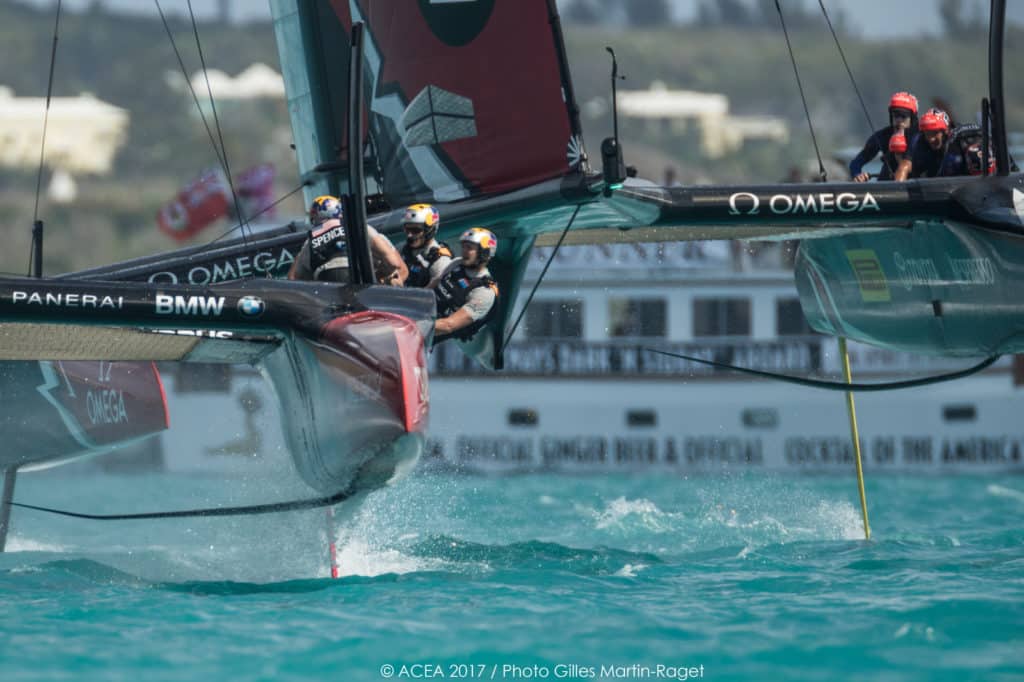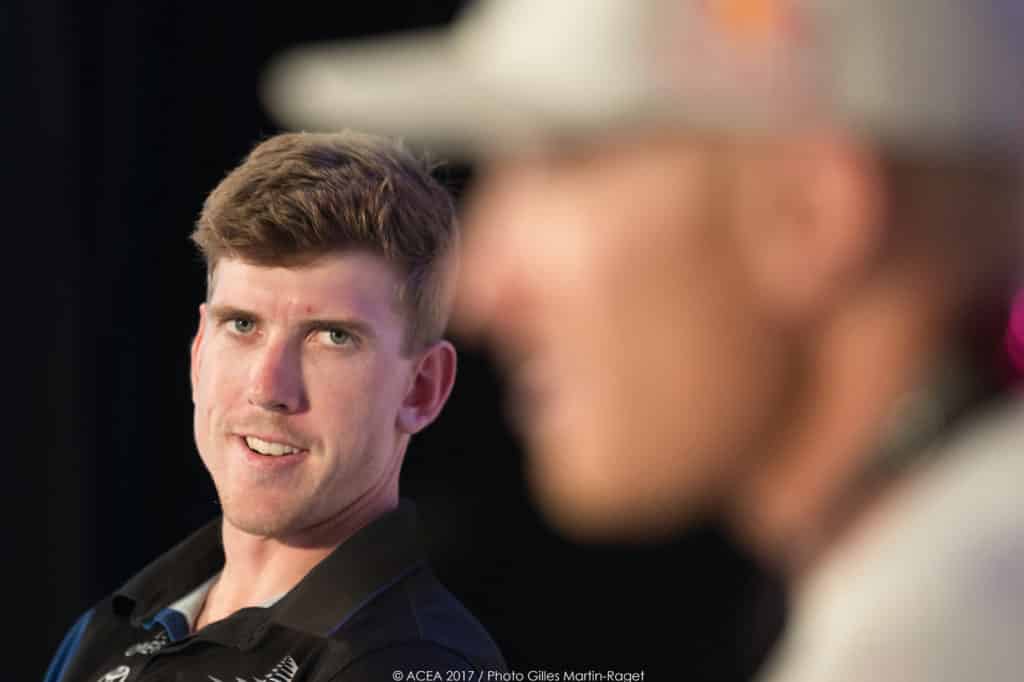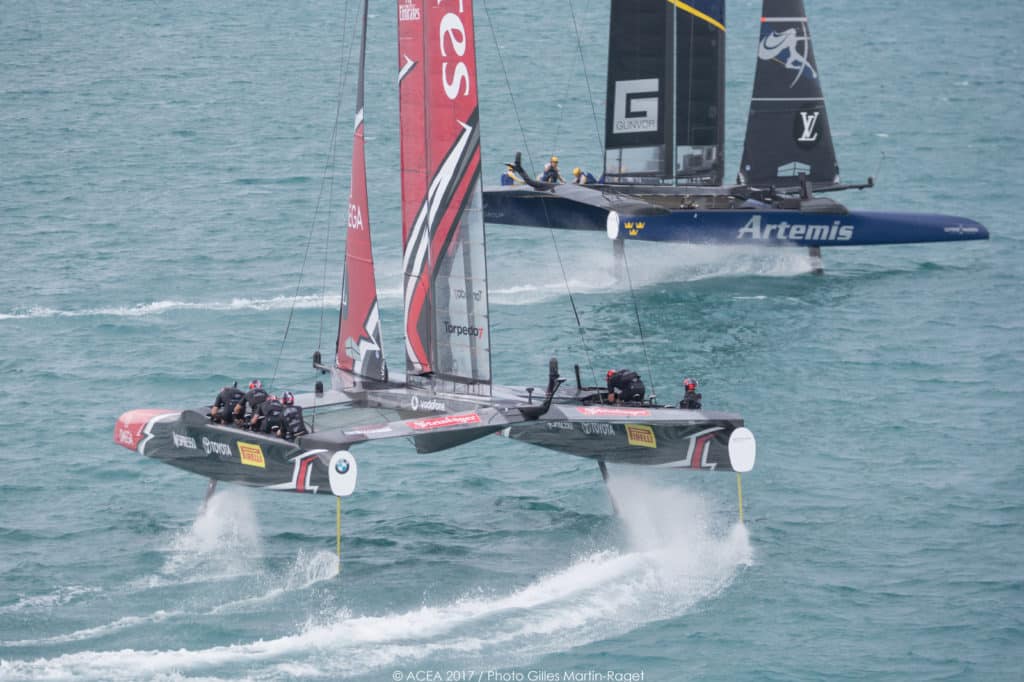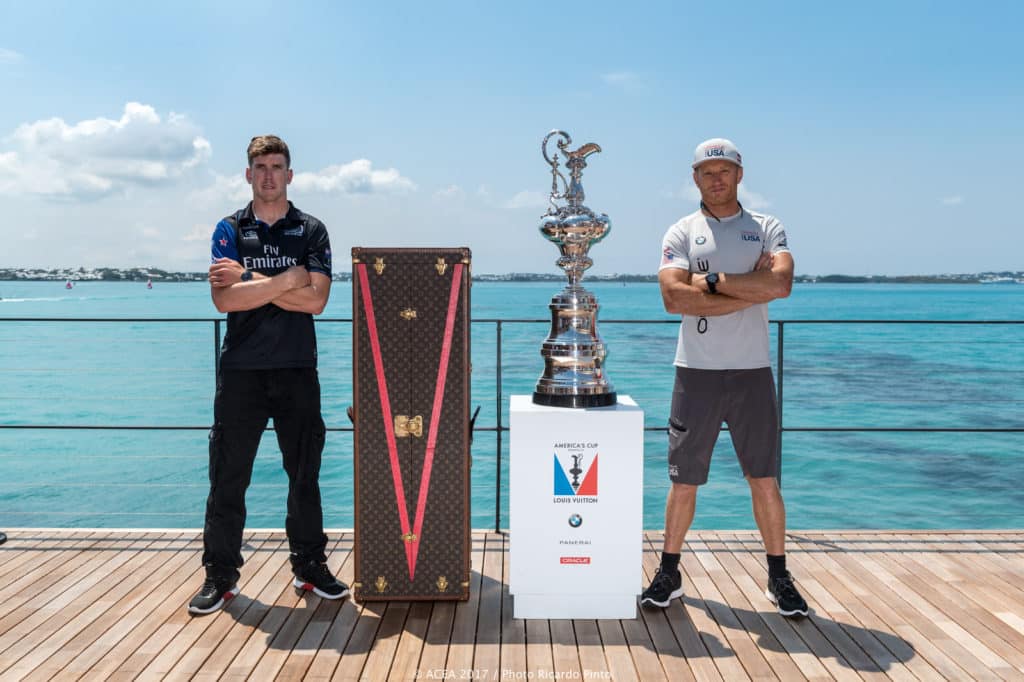
“On the eve of the 35th America’s Cup in Bermuda, the scene is as one should and would expect. Team bases are quiet as the work is done and the sailors have gone home. The America’s Cup village is closed and set up for tomorrow’s onslaught of ticket holders, VIPs, and anyone else with a purpose on the man-made island in Great Sound.”
The helmsman’s opening press conference lasted all of 20 minutes, with the usual quotes provided from two of the most efficient quote machines, Mr. James Spithill of Oracle Team USA and Mr. Peter Burling of Emirates Team New Zealand.
Both helmsmen agree they are about to enter “battle.” And each team will have something up its sleeve. Only when there are results on the scoreboard can we really say whom has the better package and whom has the skill to use it.
By nature of winning the Louis Vuitton America’s Cup Challenger Playoffs, Oracle Team USA enters the day with zero points. Emirates Team New Zealand starts with -1. That’s the scheme they agreed to with the Protocol. So in essence, the first race is chance for Oracle to size up pace of Emirates Team New Zealand and for New Zealand likewise, but with chance to bring the scorecard even. As Burling said in the conference: it’s not the first win that matters, but the last.”

What each team will show up with is anyone’s guess, but rest assured the respective AC50 platforms will be different than they were in their last televised performances. In the Louis Vuitton Series, 8 to 12 knots of wind was Emirates Team New Zealand’s sweet spot. Artemis Racing Team coach Tom Burnham, who had a keen eye on the Playoff finals, confirmed so earlier in the week. And guess what the forecast is for the first two races of the first-to-seven-point series?
Yes, 8 to 12. And sunny. And warm. Just like the Bermuda Tourism promised.
It’ll be a good series, say Burnham, especially if Emirates Team New Zealand somehow gets its way out of the starting box. Burnham’s insight is deep, so for a better understanding of what may or may not go down in this weekend’s races, I present is here. Take it from the expert. Enjoy the racing. And keep your bookmarks here.
“So basically there’s a human input, but you’re copying what the computer is telling you to do. It sounds like it’s telling them what to do.”
Emirates Team New Zealand advanced to the America’s Cup with the faster platform; how so?
Tom Burnham: I wouldn’t say they delivered a faster platform across the entire range, but they were better in that 8- to 12-knot range. That’s their strong point, and unfortunately that’s what we met them in. We were going well and could maneuver well, but Team New Zealand were just slightly better, and the thing is, it doesn’t take much. It doesn’t need to be a huge leap. In that range the guys could sail as well as they could, tactically, but it’s hard to keep a faster boat behind you.
How were they so strong in that piece of the wind range? They have daggerboards with interchangeable tips, and they’ve done a good job with the sizing of their daggerboards. They also have a pretty amazing flight control system that is very computerized and helps them in a lot of areas.
How do they so easily change the tips? I don’t know how they swap them in and out, probably mechanical fastners and filler because they are changing them day to day. I’m sure there are tradeoffs, maybe they are heavier than our boards were, but I that was a good solution that helped them by having a few more options than some of the other teams.
Any idea how many tips are in their quiver? I’m not sure exactly, but I think they have the equivalent of eight different daggerboards. They might have even more than we know about.
And about this flight-control system; what can you tell us? Supposedly, they have an iPad-like device that has a dot that moves around the screen. There’s a rule that you can’t have rake control and all that stuff linked directly to the computer system. It has to be completely separated from the boat’s system that’s tied into boatspeed, heading, angle, pitch and all that stuff. They have to be physically separated and can’t be linked in any way because otherwise, the computer could fly the boat.
The way they may have gone around this is by using an iPad that’s showing the best place to put the foils to fly the boat. So basically there’s a human input, but you’re copying what the computer is telling you to do. It sounds like it’s telling them what to do. If it’s doing what we think it is, it’s actually a really cool development that could trickle down and be used on some of the modern foiling cats where it could essentially fly the boat for you.
“You can’t come out of a tack and do all sorts of things to your wing, change your jib tension, move your leads and everything else, and then expect to tack 20 seconds later because there’s nothing left.”
How does that influence the division of labor for them? They have three guys sailing the boat; Glen [Ashby] trimming the jib and the wing, Blair [Tuke] flying the boat, and Pete [Burling] steering, with the other guys making oil. In some ways he’s singlehanding the boat, steering and doing tactics.
We spread it out a bit more, and that’s one of the biggest misconceptions in this whole Cup; how difficult each role is technically, not just physically, for the grinders. There’s a lot of managing different settings, buttons to deal with and functions to activate. All the grinders and everyone on the boat are continuously adjusting and people don’t realize how big of an impact it has on the racing. They’re not just hamsters.
So what exactly would an Artemis grinder be doing? Basically the guy at the front of the boat was managing the oil flow throughout the boat, where it’s going and how it’s being used. It’s much more complicated than grinding away, creating oil, and then letting someone use it. There’s a lot of management to fill certain accumulators. There isn’t just one big tank that you can use for whatever you want. There are a lot of rules about what can be used for different functions from different accumulators and most things aren’t allowed to be used through accumulators.
For example, any time you trim the jib or do anything with the wing twist or change the shape of the wing, or jib lead or cunningham, they all have to be generated at that moment, and every time you used one of those functions it’s less time you’re filing up your accumulators for the next time you have to use a board drop. So managing that usage is a big part of the game. You can’t come out of a tack and do all sorts of things to your wing, change your jib tension, move your leads and everything else, and then expect to tack 20 seconds later because there’s nothing left. There’s a lot of tactical awareness by those guys to know what’s coming up next so they have the ability to execute the next maneuver.
We had [Luke Parkinson], the second guy back trimming the jib and he was constantly on the jib in and out of every tack, the marking roundings, crosses, and lulls, and again, that requires oil and mental capacity that you don’t have a lot of when you’re 200 beats per minute for 20 minutes. There are floor buttons, hand buttons, and rocker switches, so they’re constantly on and off the handles.
That’s maybe one advantage the New Zealanders have is that their hands are free all the time, except when they’re holding on for dear life. There’s a lot of skill and foresight that goes into it. You can easily capsize the boat by not easing the jib when you’re going into a leeward mark rounding. If the jib is trimmed on too tight, you invert the wing going into the rounding and you’re going over. It’s not as easy as it looks.
How often are race tactics dictated by oil demands? It happens often, and to every team, where you just don’t have the oil to tack on someone and then tack again. It’s pretty rare to be able to string two good maneuvers together within 25 to 30 seconds of each other, so any sort of tacking duel, which we saw a lot of the races we were involved in, was pretty impressive, execution-wise and planning-wise to make sure you knew you had the oil to be able to pull it off.

“You can go after him because he does make mistakes tactically and with rules situations. It is definitely one of the best ways to do it, but you have to be strategic about it. You have to use your card when you have the best opportunity to do it.”
Was that the case in the Playoffs race against the New Zealanders where a covering tack didn’t stick? The boats have such narrow apparent wind angles that it’s really difficult to tack on somebody and affect their breeze – on either side. You can’t really leebow with these boats. It does help a little bit in that you can force them to sail a higher mode than they’d like to. When you tack on somebody there’s only like a 15-degree window where you can get on their air. You’d be amazed how close to leeward and behind someone can be and still have clear air forward.
The polar curves are such that when you put the bow down and go 4 knots faster, and your VMG is like 1 or 2 percent slower, so you’re just hauling, get clear air and turn back up again. It’s very difficult to sit on somebody.
If Burling is a one-man tactical band, is it an effective strategy to go on the offensive with him right away? You can go after him because he does make mistakes tactically and with rules situations. It is definitely one of the best ways to do it, but you have to be strategic about it. You have to use your card when you have the best opportunity to do it. If Team New Zealand are in their wind range it can leave you really exposed. At the same time, if he is quicker and you let him go, you’re screwed as well. It’s a tough one to manage. You have to be selective. I give our team a lot of credit; they did it well. We just met them in a range when they were strong.
All this talk of foils and controls, what about Ashby’s wing? Emirates Team New Zealand are more active on their trim. No question, the pedal system makes a lot of oil and they use a lot of oil. But they are susceptible to not having enough oil for a maneuver here and there like everyone else because they use more than the rest of us do. Glen has a lot of control over the wing and uses it a lot to control twist more aggressively and more frequently than the other teams, I think. It seems to be working well for them.
Another weakness could be the fact that there is one person steering, one person flying the boat, and one person doing all that trimming. They are very separated from each other whereas with other teams the helmsman is still flying the boat, right there next to the wing trimmer.
I do believe the fact that Blair was flying the boat and Pete was steering contributed to the capsize, because the helmsman would have taken care of that issue before they bore away. So maybe that could make it more difficult for them, unless their software is all intuitive and knows Glen is changing the twist profile and Blair counteracts by moving the board in a certain way, maybe it all is built into the system. It would be very complex, but very possible.

How do Oracle Team USA and Emirates Team New Zealand play each other this weekend? They will stick to what they know best. We know both of them have been making more developments since the last time they raced. They will get a feel for each other and Jimmy [Spithill] will be aggressive and win starts. If Team New Zealand is not faster than they were against us, they will struggle, but if there are, they will have a fight on their hand with Tom [Slingsby]. I think it will be a good series.
That said, there’s no way Team New Zealand will have gotten that much better at starting since we raced them and Jimmy and those guys are good at starting. They will be pushing some situations. If it’s the right wind speed for New Zealand it will be a tough fight, but if it’s in Oracle’s range, it will be a bit easier for them because they’re better in the starts on average.









